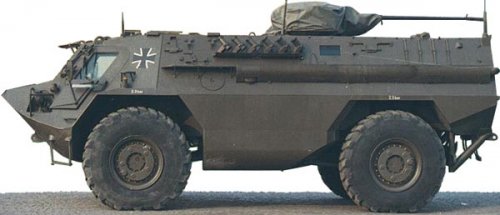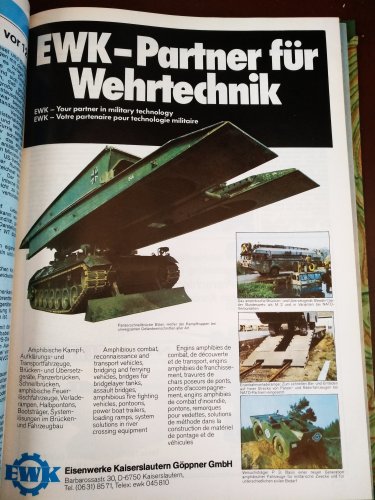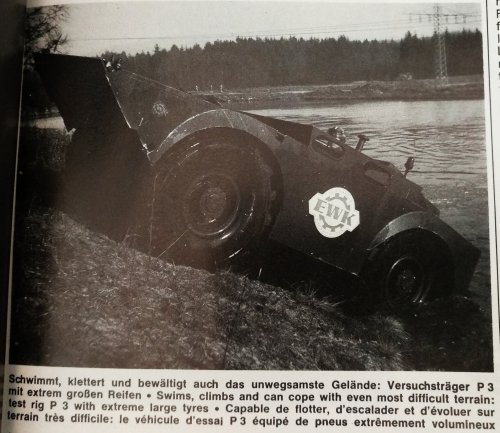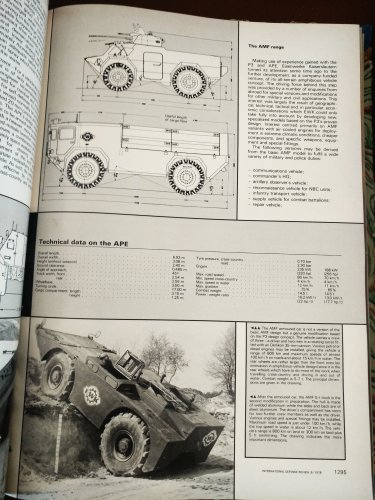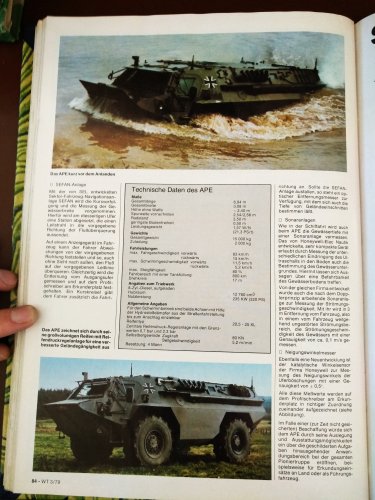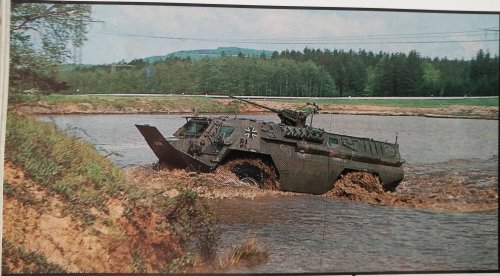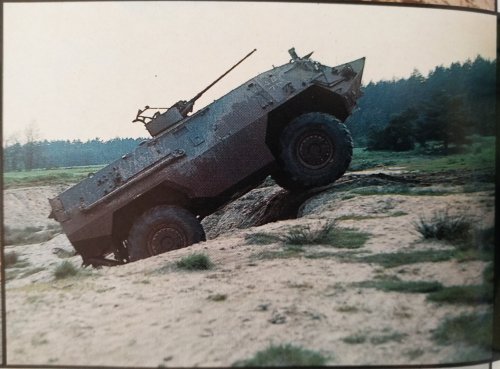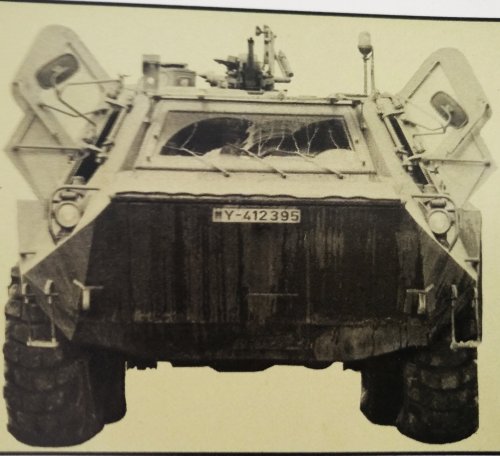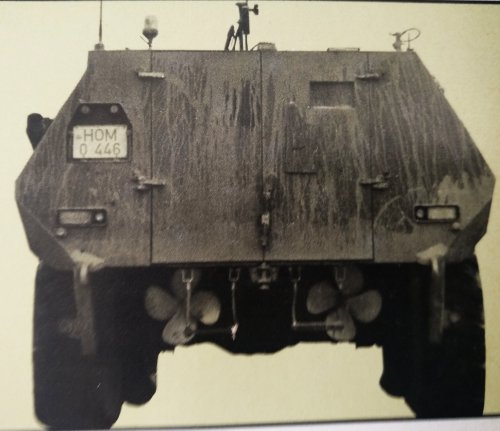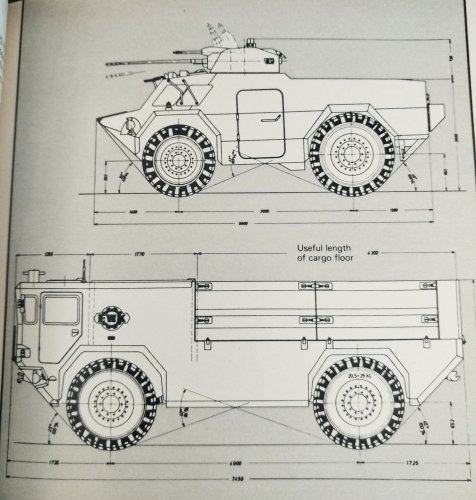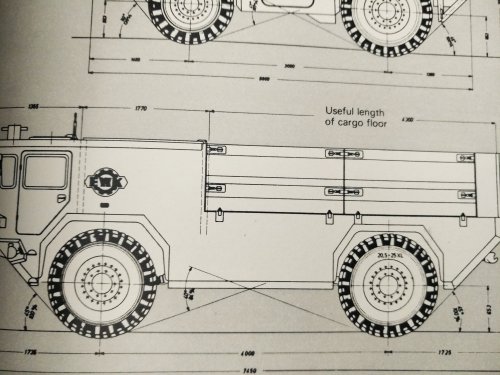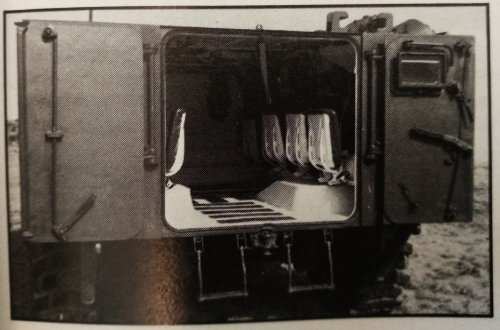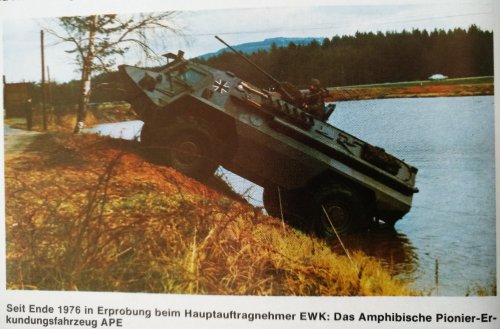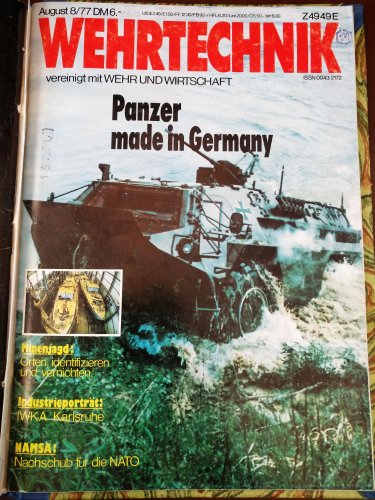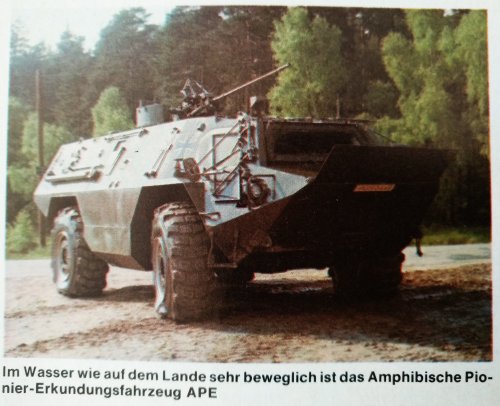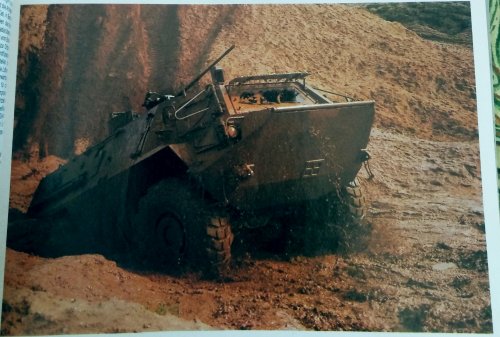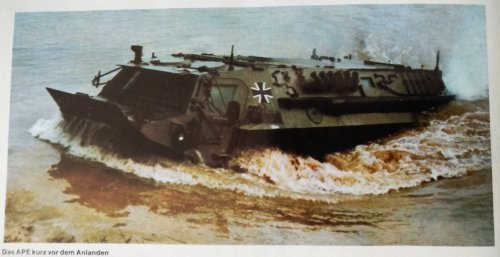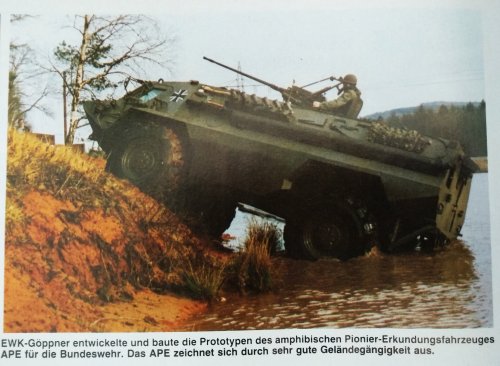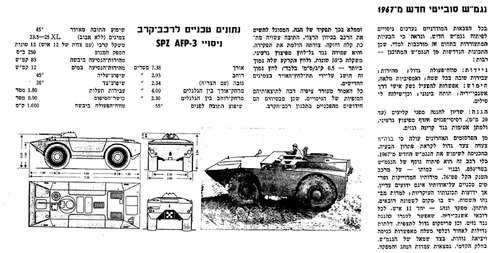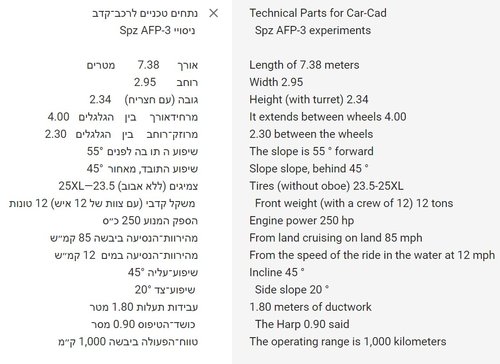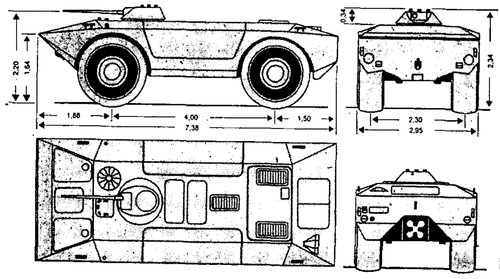- Joined
- 18 March 2008
- Messages
- 3,529
- Reaction score
- 843
The following information has been copied from Jane’s Light Tanks and Armoured Cars 1984 by Christopher F. Foss. It is posted here for educational purposes:
APE Amphibious Engineer Reconnaissance Vehicle
Development
In the early 1960s EWK (Eisenwerke Kaiserslautern Göppner GmbH) developed a cross-country trials vehicle known as the P3 Erprobungswagen. This vehicle featured large Michelin low-pressure tyres (2100 × 25XL) with a diameter of 1.744 metres and a tread of 0.569 metre and a central tyre pressure system that allowed the driver to adjust the ground pressure to suit the type of ground being crossed. The P3 had a wheelbase of 3.3 metres and a low centre of gravity owing to its overall height of only 2.05 metres, and was fully amphibious being propelled in the water at a speed of 12 km/h by one propeller. Extensive trials showed that the P3 had excellent cross-country and amphibious capabilities and could climb and descend steep river banks with ease.
In the early 1970s EWK, with Daimler-Benz as the major sub-contractor, started development work on the APE (Amphibisches Pionier-Erkundungsfahrzeug), or Amphibious Engineer Reconnaissance Vehicle, to meet the requirements of the Federal German Army. EWK also call the vehicle the AMF (Amphibische Mehrzweck-Fahrzeuge) or Amphibious Reconnaissance Vehicle.
The first prototype of the APE was completed in 1977. The vehicle is basically a slightly larger version of the Transportpanzer 2 (4 × 4) vehicle incorporating many of the concepts already proved in the earlier P3 prototype. The Transportpanzer 1 (6 X× 6) vehicle is currently in production for the Federal German Army by Thyssen Henschel and the first of 996 vehicles were handed over late in 1979. About 90 per cent of the automotive components of the APE are identical to those of the Transportpanzer 1 but its suspension is quite different and for this reason it has superior amphibious and cross-country capabilities to the Transportpanzer 1. EWK built four prototypes of the APE for the West German Army and one of these was subsequently bought back by the company for further development work. This was subsequently renamed the Alligator.
The main features of the APE are low-pressure balloon tyres, tyre pressure regulation system, good angles of approach and departure, hydraulic retraction of the axles when the vehicle is swimming, reducing drag to an absolute minimum, ability of the two propellers to swivel through 360 degrees for increased manoeuvrability, capability of the wheels and propellers to be driven simultaneously to assist in climbing out of the water, and excellent forward visibility.
Description
The all-welded steel hull of the APE provides the crew with protection from small arms fire and shell splinters. The hull has a rhomboid cross section and incorporates spaced armour in certain areas.
The driver is seated at the front of the hull on the left with the vehicle commander to his right. A bulletproof windscreen in front of them can be covered by an armoured shutter. The driver is provided with a circular roof hatch that opens forwards and the commander has a similar rear-opening hatch. Periscopes are fitted in the roof of the vehicle, in front of the driver’s and commander's hatches, for use when the windscreen is covered by the armoured shutter. Both the driver and commander are provided with an entrance door in the side of the vehicle with an integral bulletproof window which is also covered by an armoured shutter in combat areas.
The complete powerpack is behind the driver and commander and access is by a hatch in the roof. There is a small passage between the front of the vehicle and the passenger/cargo area at the rear on the right side of the hull. The vehicle is powered by the same engine as the Transportpanzer 1 which can be replaced by a Daimler-Benz diesel which develops 265 hp giving the vehicle a power-to-weight ratio of 18.27 hp/tonne, a maximum road speed of 70 km/h and a water-speed of 11 km/h.
The load area is at the rear of the hull and is 3.15 metres long and 1.25 metres high with a small vision port protected by an armoured shutter in each side. There are three roof hatches over the load area. The first circular hatch is normally used to mount the main armament installation and the second and much smaller circular hatch is to the right and rear of the first one. The third hatch is square and is at the left rear and opens forward. Normal means of entry is by two large doors at the rear of the hull. The right door has a vision port covered by an armoured shutter when not required.
The APE has a central tyre pressure regulation system which allows the driver to adjust the tyre pressure to suit the type of ground being crossed, which is of particular use when climbing steep banks and crossing deep mud.
The vehicle is fully amphibious, being propelled in the water by two Schottel four-bladed propellers beneath the floor level of the vehicle at the rear of the hull which remain in the water as long as possible when the vehicle is leaving the water. When afloat the axles and wheels are retracted to reduce drag. Before entering the water a trim vane is erected at the front of the vehicle and standard equipment includes three bilge pumps with a capacity off 80 litres a minute each. The APE is fitted with an NBC system.
The basic vehicle is armed with a Rheinmetall 20 mm cannon mounted on a Keller and Knappich E-6 mount, and six smoke dischargers mounted on the left side of the hull.
Variants
EWK has suggested that the vehicle could be used for a variety of other roles including armoured personnel carrier, anti-tank (with turret-mounted gun or ATGWs), artillery fire-control vehicle, ambulance, command vehicle, com¬munications vehicle, internal security vehicle, mortar carrier, NBC reconnaissance vehicle, reconnaissance vehicle, repair vehicle or a supply carrier.
The company is also developing, as a private venture, an armoured car in the 5000 to 7000 kg range which will incorporate features of the APE and will be armed with a turret-mounted 35 mm cannon and a coaxial 7.62 mm machine gun.
SPECIFICATIONS
CREW 12 (10 in troop compartment)
CONFIGURATION 4 × 4
COMBAT WEIGHT 14 500 kg
POWER-TO-WEIGHT RATIO 22 hp/tonne (approx)
LENGTH 6.93 m
WIDTH 3,08 m
HEIGHT (to hull top) 2.4 m
GROUND CLEARANCE (axles) 0.485 m (hull) 0.555 m
TRACK (front/rear) 2.54 m/2.56 m
WHEELBASE 3.5 m
ANGLE APPROACH/DEPARTURE 45°/45°
MAX SPEED (road forwards) 83 km/h (water) 12 km/h
MAX RANGE (cross-country) 800 km
GRADIENT 75%
SIDE SLOPE 30%
TURNING RADIUS 8.5 m
ENGINE Mercedes-Benz OM 402A V-8 liquid-cooled diesel developing 320 hp at 2500 rpm
TRANSMISSION ZF 4 HP 500-1 6-speed automatic with in-line torque converter
STEERING hydraulic, recirculating
TYRES 20.50 × 25 XL
BRAKES (main) hydraulic, air-assisted (dual circuit) (parking) mechanical
ELECTRICAL SYSTEM 28 V dc
BATTERIES 4 × 12 V, 200 Ah
ARMAMENT (main) 1 × 20 mm
SMOKE-LAYING EQUIPMENT 6 smoke dischargers
Status: Development complete. Ready for production.
Manufacturer: Eisenwerke Kaiserslautern Göppner GmbH, Barbarossa 30, D-6750 Kaiserslautern, Federal Republic of Germany.
http://i76.photobucket.com/albums/j35/abegubler/ape01.jpg
APE amphibious engineer reconnaissance vehicle armed with 20 mm cannon
http://i76.photobucket.com/albums/j35/abegubler/ape02.jpg
APE amphibious engineer reconnaissance vehicle armed with 20 mm cannon
APE Amphibious Engineer Reconnaissance Vehicle
Development
In the early 1960s EWK (Eisenwerke Kaiserslautern Göppner GmbH) developed a cross-country trials vehicle known as the P3 Erprobungswagen. This vehicle featured large Michelin low-pressure tyres (2100 × 25XL) with a diameter of 1.744 metres and a tread of 0.569 metre and a central tyre pressure system that allowed the driver to adjust the ground pressure to suit the type of ground being crossed. The P3 had a wheelbase of 3.3 metres and a low centre of gravity owing to its overall height of only 2.05 metres, and was fully amphibious being propelled in the water at a speed of 12 km/h by one propeller. Extensive trials showed that the P3 had excellent cross-country and amphibious capabilities and could climb and descend steep river banks with ease.
In the early 1970s EWK, with Daimler-Benz as the major sub-contractor, started development work on the APE (Amphibisches Pionier-Erkundungsfahrzeug), or Amphibious Engineer Reconnaissance Vehicle, to meet the requirements of the Federal German Army. EWK also call the vehicle the AMF (Amphibische Mehrzweck-Fahrzeuge) or Amphibious Reconnaissance Vehicle.
The first prototype of the APE was completed in 1977. The vehicle is basically a slightly larger version of the Transportpanzer 2 (4 × 4) vehicle incorporating many of the concepts already proved in the earlier P3 prototype. The Transportpanzer 1 (6 X× 6) vehicle is currently in production for the Federal German Army by Thyssen Henschel and the first of 996 vehicles were handed over late in 1979. About 90 per cent of the automotive components of the APE are identical to those of the Transportpanzer 1 but its suspension is quite different and for this reason it has superior amphibious and cross-country capabilities to the Transportpanzer 1. EWK built four prototypes of the APE for the West German Army and one of these was subsequently bought back by the company for further development work. This was subsequently renamed the Alligator.
The main features of the APE are low-pressure balloon tyres, tyre pressure regulation system, good angles of approach and departure, hydraulic retraction of the axles when the vehicle is swimming, reducing drag to an absolute minimum, ability of the two propellers to swivel through 360 degrees for increased manoeuvrability, capability of the wheels and propellers to be driven simultaneously to assist in climbing out of the water, and excellent forward visibility.
Description
The all-welded steel hull of the APE provides the crew with protection from small arms fire and shell splinters. The hull has a rhomboid cross section and incorporates spaced armour in certain areas.
The driver is seated at the front of the hull on the left with the vehicle commander to his right. A bulletproof windscreen in front of them can be covered by an armoured shutter. The driver is provided with a circular roof hatch that opens forwards and the commander has a similar rear-opening hatch. Periscopes are fitted in the roof of the vehicle, in front of the driver’s and commander's hatches, for use when the windscreen is covered by the armoured shutter. Both the driver and commander are provided with an entrance door in the side of the vehicle with an integral bulletproof window which is also covered by an armoured shutter in combat areas.
The complete powerpack is behind the driver and commander and access is by a hatch in the roof. There is a small passage between the front of the vehicle and the passenger/cargo area at the rear on the right side of the hull. The vehicle is powered by the same engine as the Transportpanzer 1 which can be replaced by a Daimler-Benz diesel which develops 265 hp giving the vehicle a power-to-weight ratio of 18.27 hp/tonne, a maximum road speed of 70 km/h and a water-speed of 11 km/h.
The load area is at the rear of the hull and is 3.15 metres long and 1.25 metres high with a small vision port protected by an armoured shutter in each side. There are three roof hatches over the load area. The first circular hatch is normally used to mount the main armament installation and the second and much smaller circular hatch is to the right and rear of the first one. The third hatch is square and is at the left rear and opens forward. Normal means of entry is by two large doors at the rear of the hull. The right door has a vision port covered by an armoured shutter when not required.
The APE has a central tyre pressure regulation system which allows the driver to adjust the tyre pressure to suit the type of ground being crossed, which is of particular use when climbing steep banks and crossing deep mud.
The vehicle is fully amphibious, being propelled in the water by two Schottel four-bladed propellers beneath the floor level of the vehicle at the rear of the hull which remain in the water as long as possible when the vehicle is leaving the water. When afloat the axles and wheels are retracted to reduce drag. Before entering the water a trim vane is erected at the front of the vehicle and standard equipment includes three bilge pumps with a capacity off 80 litres a minute each. The APE is fitted with an NBC system.
The basic vehicle is armed with a Rheinmetall 20 mm cannon mounted on a Keller and Knappich E-6 mount, and six smoke dischargers mounted on the left side of the hull.
Variants
EWK has suggested that the vehicle could be used for a variety of other roles including armoured personnel carrier, anti-tank (with turret-mounted gun or ATGWs), artillery fire-control vehicle, ambulance, command vehicle, com¬munications vehicle, internal security vehicle, mortar carrier, NBC reconnaissance vehicle, reconnaissance vehicle, repair vehicle or a supply carrier.
The company is also developing, as a private venture, an armoured car in the 5000 to 7000 kg range which will incorporate features of the APE and will be armed with a turret-mounted 35 mm cannon and a coaxial 7.62 mm machine gun.
SPECIFICATIONS
CREW 12 (10 in troop compartment)
CONFIGURATION 4 × 4
COMBAT WEIGHT 14 500 kg
POWER-TO-WEIGHT RATIO 22 hp/tonne (approx)
LENGTH 6.93 m
WIDTH 3,08 m
HEIGHT (to hull top) 2.4 m
GROUND CLEARANCE (axles) 0.485 m (hull) 0.555 m
TRACK (front/rear) 2.54 m/2.56 m
WHEELBASE 3.5 m
ANGLE APPROACH/DEPARTURE 45°/45°
MAX SPEED (road forwards) 83 km/h (water) 12 km/h
MAX RANGE (cross-country) 800 km
GRADIENT 75%
SIDE SLOPE 30%
TURNING RADIUS 8.5 m
ENGINE Mercedes-Benz OM 402A V-8 liquid-cooled diesel developing 320 hp at 2500 rpm
TRANSMISSION ZF 4 HP 500-1 6-speed automatic with in-line torque converter
STEERING hydraulic, recirculating
TYRES 20.50 × 25 XL
BRAKES (main) hydraulic, air-assisted (dual circuit) (parking) mechanical
ELECTRICAL SYSTEM 28 V dc
BATTERIES 4 × 12 V, 200 Ah
ARMAMENT (main) 1 × 20 mm
SMOKE-LAYING EQUIPMENT 6 smoke dischargers
Status: Development complete. Ready for production.
Manufacturer: Eisenwerke Kaiserslautern Göppner GmbH, Barbarossa 30, D-6750 Kaiserslautern, Federal Republic of Germany.
http://i76.photobucket.com/albums/j35/abegubler/ape01.jpg
APE amphibious engineer reconnaissance vehicle armed with 20 mm cannon
http://i76.photobucket.com/albums/j35/abegubler/ape02.jpg
APE amphibious engineer reconnaissance vehicle armed with 20 mm cannon

